#champions 1617
Text



On June 14/15th/1617/18 th we are excited to announce an unmissable event for all Brazilian Jiu Jitsu enthusiasts! The legendary Rodrigo Antônio, known to many as Rodrigo Feijão, will hold an exclusive internship at our gym.
🥋🥋🥋
Feijão, a black belt in Brazilian Jiu Jitsu, was a key figure on Nova União's lightweight team in the late 1990s and early 2000s. With a distinguished career as both an athlete and a coach, Feijão has contributed significantly to the development of Jiu Jitsu in Brazil, training numerous champions through his academy in Maringá. Among his most illustrious students are Alex Sodré, Fabricio Nascimento, Michel Maia, Felipe Vidal, Rene Nazare and Daniel Garcia Dias and many others.
🥋
Don't miss this unique opportunity to learn from the best! The internship will be held in Brescia at the Olimpic Sauna Gym. It will be an extraordinary opportunity to improve your techniques, learn new details and train with one of the great masters of our sport.
📌
Sign up now and get ready for an unforgettable experience!
.
#BJJ #RodrigoFeijão #JiuJitsu #TrainingCamp #Maringá #BrazilianJiuJitsu #Grappling #MartialArts #SelfDefense #BJJLife #BJJFamily
🟢
We are waiting for you on the tatami!
0 notes
Photo




In 1610, Thomas Milles, champion of exhausting exhaustive titles, wrote The Catalog of Honor; or, Tresvry of Trve Nobility, Pecvliar and Proper to the Isle of Great Britaine, or, Tresury of true nobility : peculiar and proper to the isle of Great Britaine : that is to say, a collection historicall of all the free monarches aswell kinges of England as Scotland (nowe vnited togither) with the princes of Walles, dukes, marquisses and erles, their wiues, children, alliances, families, descentes & achievementes of honor : wherunto is properly prefixed, a speciall treatise of that kind of nobility which soverayne grace and fauor, and contryes customes, haue made meerly politicall and peculiarly ciuill (neuer so distinctly handled before) / translated out of Latyne into English. It was published by William Jaggard, a printer and bookseller in London between 1594 and 1623. He published many religious commentaries, books on British heraldry, essays, and histories. Jaggard printed eight other of Milles’ works.
Milles, a customs official, bailiff, and intelligence agent, was born in 1550(?) in Ashford, Kent, England. An avid advocate of mercantilism and free trade, Milles authored at least twelve printed titles between 1599 and 1617. Many were concerned with influencing economic policy, critiquing Catholocism, and documenting royal lineages.
Milles seems to have been concerned with accurately documenting the histories and lineage of Great Britain’s “True Nobility” in The Catalog of Honor, perhaps in response to a century with multiple royal lineage disputes, rife with political and religious upheaval. The 16th century saw the rise and fall of Mary I, Elizabeth I selling much of her holdings to finance foreign and domestic wars, the failure of the Tudor government system, and the 1690s depression. In 1603, Queen Elizabeth I died without an heir and was succeeded by James IV of Scotland, her closest living relative (and son of Mary, Queen of Scots).
The Catalog of Honor documents the titles and lineage of nobility, complete with engravings of their sigils. The first portion is a translation of Robert Glover’s Nobilitas politica vel civilis, with a title page engraving by Renold Elstracke. The widespread concern with accurate lineage is evidenced in the multiple copies where Charles Bount’s illegitimate son Mountjoy Blount. He was later recognized and bestowed with the title of Baron and Earl a year later. In UWM’s copy, a paragraph referencing Mountjoy was cut out and later restored in manuscript.
A later book by Ralph Brooke, A catalogue and succession of the kings, princes, dukes, marquesses, earles, and viscounts of this realme of England…discouering, and reforming many errors committed, by men of other profession, and lately published in print; to the great wronging of the nobility, and preiudice of his Maiesties officers of armes, who are onely appointed and sworne to deale faithfully in these causes., was written in part to correct errors made by Milles in The Catalog of Honor.
0 notes
Photo



Cristiano siendo manteado | 03.06.2017
1K notes
·
View notes
Photo



CHAMPIOOOOONS OF ENGLAND!
87 notes
·
View notes
Photo

The Four Seasons, Kano Tan’yū, 1668, Cleveland Museum of Art: Japanese Art
Tan'yū's skills were honed early within the regimen of the Kano family's painting studio. His grandfather, Eitoku (1543–1590) was the Momoyama period's most sought-after painter, a champion of colorful, large-scale painting compositions who worked for several of the country's most powerful leaders. When the young Tan'yū was summoned to Edo in 1617 by the shogun to become a member of the new capital's official painting studio, few opportunities to work on similarly ambitious projects existed. Yet by the end of his career, Tan'yū had supervised the execution and installation of linked mural painting compositions in several of Japan's most prestigious residences and castles. As an official court painter to the first shogun, Tokugawa Ieyasu (reigned 1603–5), and then his successors, Tan'yū appears to have successfully juggled his official duties with private activities as a teacher, as the era's leading connoisseur of classic Chinese and Japanese painting, and as a practicing artist. His surviving compositions as well as thousands of sketches far surpass the oeuvre of any of his contemporaries. While studio assistants surely contributed to his oeuvre, just as later imitators consciously confused his accomplishments, a clearer image of the painter has emerged in recent years that better conforms with his contemporary acclaim as recorded in seventeenth- and eighteenth-century documents.
Tan'yū can now be seen as an artist adept in virtually all traditional ink painting subject matter, which he often presented in novel interpretations. Equally important are his rare screen (byōbu) compositions executed in a pure yamato-e manner with vivid mineral pigments on a gold-foil background. This pair of byōbu presents Tan'yū's more orthodox approach to academic ink painting methods embracing Chinese themes that had been interpreted by numerous Japanese ink painters over the centuries. Thus a typical view of residences and human activities set along the shores of an impressive river (or lake) is enlivened by the Japanese proclivity for including seasonal references. Proceeding from right to left, the viewer passes sequentially from spring to the snow-laden branches of winter.
Tan'yū lends considerable atmospherics to the panorama in his use of misty cloud banks, frequently set off by sharp, darkened ink lines or whole areas of ink washes of variegated tonalities. The spring and summer views are particularly notable in this regard, as is the presence of the artist's signature on both byōbu, attesting to their completion in Tan'yū's sixty-seventh year (1668)—50 years after he left Kyoto for the capital, and 30 years following his adoption of the artist name "Tan'yū" (in 1635). From 1622, when he began work on the mural paintings for Edo castle (the shogun's formal residence), through the completion of the painting cycle in 1636 for the Tokugawa family mausoleum in Nikkō to the north of Edo, Tan'yū's skills as head of an accomplished painting studio as well as a master painter found their most impressive expression in large-scale compositions. In 1638 he received the honorary Buddhist title Hōgen (Eye of the Law). It is intriguing therefore that relatively few independent byøbu paintings from the master's hand survive, particularly documented early works.
Size: Image: 174 x 381 cm (68 1/2 x 150 in.)
Medium: Six-panel folding screen, ink and slight color on paper
https://clevelandart.org/art/1992.394.2
26 notes
·
View notes
Photo



Ramos and Isco celebrate Real Madrid’s passage to the UCL final | May 10, 2017
- Part 2
375 notes
·
View notes
Photo

Portrait of Woman, called Lucy Percy, Countess of Carlisle, Adriaan Hanneman, c.1650, Minneapolis Institute of Art: Paintings
Portrait of a woman in a green dress and brown scarf with flowers in her hair, pearl necklace and earrings, at a fountain. Lucy Percy (1599–1660) was one of the best known ladies at the court of King Charles I of England. She was a celebrated wit and had a penchant for political intrigue and scandal. In 1617 she married the notorious rake, James Hay, Earl of Carlisle, without her father's consent. She quickly involved herself in court circles, eventually becoming an intimate friend of Queen Henrietta Maria. After the death of her husband, she shifted her loyalty to the Republican party and was able to give its leaders important information concerning the royal family. Upon the restoration of Charles II, she conveniently switched her affections back to the Royalists, and tried to regain her position at court. But before she could make any marked progress in this direction, she died. Conservation of this picture was made possible by a generous contribution from Al and Dena Naylor through the Art Champions program.
Size: 32 x 26 in. (81.28 x 66.04 cm) (canvas)
Medium: Oil on canvas
https://collections.artsmia.org/art/474/
7 notes
·
View notes
Text
Tam Nakano & Kagetsu’s Greatest Hits: Being a summary of my favorite wrestling feud with links
NOTE: This post assumes you have a Stardom World subscription or know someone who does.
In 2017, Tam Nakano, the Stardom Dream, hasn’t been in World Wonder Ring Stardom very long. She was an idol singer first, then she got famous doing exploding bat deathmatches (which are more or less what they sound like). Stardom signed her, but she’s out of her element, there’s no gimmicks here. With no friends and no bats, she hasn’t been winning much and she’s starting to feel really lost.
In the 5 Star Grand Prix Tournament, she fights Io Shirai, the ace of Stardom and leader of Queen’s Quest (a faction of super competitive tomboy types). The girls who check on her after her match are Hana Kimura and Kagetsu from Oedo Tai (a faction of hot goths who don’t play by the rules). Queen’s Quest and Oedo Tai fucking hate each other and this will be important later. https://www.stardom-world.com/set/1412/contents/1403?fcid=14
Hana and Kagetsu face each other later in the same show. All of Oedo Tai is pulling for Hana to win the tournament, but Kagetsu believes her job as the leader is to make her juniors prove themselves, so she isn’t about to go easy on Hana. When the match is over, Tam sees the way Oedo Tai takes care of each other and she asks to join. More than anything, Tam wants a family, and Oedo Tai seems like that to her. https://www.stardom-world.com/set/1412/contents/1405?fcid=14
Tam gets injured pretty soon after joining and gets kind of shunted off into a manager role. It’s not the coolest thing ever, but at least she has a cool new costume and a panda stuffy. Meanwhile, another new member (Natsu Sumire) has joined Oedo Tai and the rivalry between them and Queen’s Quest has really started heating up. After an epic 4v4 match, Kagetsu has a special request for a final faceoff between the entirety of both factions. Tam is also here and she is a delight. https://www.stardom-world.com/set/298/contents/297?fcid=2
At the January 2018 Anniversary show, Oedo Tai and Queen’s Quest have a 5v5 elimination match with the stipulation that the last wrestler eliminated will be kicked out of their team. It’s a huge match for both teams and Tam is back for it. Finally, she will prove her worth to Oedo Tai now that she’s back from her injury and can fight alongside her chosen family. https://www.stardom-world.com/set/1593/contents/1592?fcid=2
Tam and her new tag partner, Mayu Iwatani, announce their intention to win the Goddess of Stardom tag team belts. The belts that Hana and Kagetsu took from Mayu and another partner not that long before all this. Needless to say, Oedo Tai sees this as a betrayal. Tam was supposed to find her own way but not like this. This is personal. https://www.stardom-world.com/set/1613/contents/1611?fcid=2
Tam and Mayu challenge for the tag belts and, well, it’s emotionally intense for everyone involved, but at least it means the feud is over right? Right? https://www.stardom-world.com/set/1620/contents/1617?fcid=2
Lol nah, Oedo Tai is as pissed as ever. Things are still extremely tense and personal. Natsu challenges Tam and a partner of Tam’s choice to a tag match against her and Kagetsu to end the feud once and for all. Any stipulation Tam wants. https://www.stardom-world.com/set/1687/contents/1686?fcid=2
IF YOU ONLY WATCH ONE MATCH IN THIS POST PLEASE MAKE IT THIS ONE!! I don’t know what else I could say here. Tam and Io get their revenge on Oedo Tai with the gimmick that made Tam famous. An exploding bat death match. I don’t want to overhype it too much, but it’s a real good capper for the feud and I just, yeah, I go back to this one a lot. https://www.stardom-world.com/set/1073/contents/1072?fcid=2
With the Oedo Tai feud more or less ended, Tam spends some time working on herself and helping to build Mayu’s new faction, Stars. She mostly plays supporting roles in other people’s stories for a long time and doesn’t get a ton to do specifically with Kagetsu. But she does have a few tense moments with Hana, and it’s interesting to see Hana and Oedo Tai starting to begrudgingly respect Tam again. She’s stronger and more confident than ever.
It’s the last match of the 2018 5 Star Grand Prix Tournament before finals. Tam hasn’t been having the best tournament. She only has one win so far, but she hasn’t been letting it get to her. Though she’s lost and lost, she’s kept her spirits up and she’s going into her match with Kagetsu with her head held high. Kagetsu, for her part, is the World Champion now and she’s won nearly all her tournament matches despite increasing tension within Oedo Tai, She only needs one more win to secure her place in finals. https://www.stardom-world.com/set/1678/contents/1676?fcid=2
At the January 2019 Anniversary show, Tam challenges Momo Watanabe for the Wonder of Stardom belt, but it’s not really about the belt. Tam remembers losing to Momo a year ago. She remembers being kicked out of Oedo Tai, losing her family and having to start over. She’s dyed her hair black like the old days, she’s made her peace with her past. And whether she wins or not, Tam is determined to prove that Stars has made her better and that she can no longer be disregarded. https://www.stardom-world.com/set/19/contents/70?fcid=1
The Cinderella tournament, a one day tournament where competitors are eliminated over the top rope, hasn’t historically gone great for Tam. She just never seems to take it especially seriously. Even meeting Kagetsu in the first round doesn’t seem to bother her. She says she thinks about fighting Kagetsu all the time. She says it nonchalantly and with a smile. Tam’s not angry anymore. She and Kagetsu are finally equals and this will be the night that proves it. https://www.stardom-world.com/set/346/contents/352?fcid=1
Through 2019, Tam’s main focus is Stars and her relationship with her teammates. She has something of a rivalry with her teammate Arisa, at first they fight over Mayu’s affections and then over the Wonder of Stardom belt after Arisa takes it off Momo. The rivalry grows into a grudging respect and I could make a whole playlist for that storyline. What’s relevant here is that by the time the Goddess of Stardom Tag League rolls around, Tam’s tense friendship with Arisa has consumed all her time and energy. When the two face Kagetsu and her new partner Andras Miyagi, Tam isn’t even thinking about Oedo Tai. What matters to her is the hope of winning the tournament and the relationship she’s built along the way. Though of course, Kagetsu hasn’t forgotten, and the draw at the Cinderella tournament was only salt on the wound. It’s been two years since the bat match and the humiliating Grand Prix defeat, and Kagetsu is still too angry for words. https://www.stardom-world.com/set/876/contents/885?fcid=1
It’s the January 2020 Anniversary show. Kagetsu has announced her retirement. Tonight is Tam and Kagetsu’s last match together and they’re going to leave it all in the ring. I have a lot of feelings about this one. I’m just gonna let you watch it.
https://www.stardom-world.com/set/1025/contents/1030?fcid=22
A month later, Kagetsu prepares for her last match in Stardom. A gauntlet match against the entire Stardom roster. Every friendship, every rivalry, every weird tense relationship in between, it all ends here for Kagetsu. Tam is here too, but for once it isn't about Tam. Here, Kagetsu gets to be the hero of her own story and pass the torch to a generation of wrestlers she helped train. And I'll be damned if it doesn't make me cry every time.
https://www.stardom-world.com/set/1127/contents/1126?fcid=22
28 notes
·
View notes
Text

Edit
Hellboy, or "Anung Un Rama" as he was called, was conceived on October 5,[1] 1617, the day his birth-mother, Sarah Hughes, a human woman, was on her deathbed. In life, Sarah was a witch who gained her powers from being a consort of the archdemon, Azzael, an Archduke of Hell, and Hellboy's "biological" father. Taking Sarah's body to hell when she attempted to repent on her deathbed within a church in East Bromwich, England, Azzael burned her away so their child would be born, and chopped off the newborn's right hand to replace it with the "Right Hand of Doom", a relic tied to the Ogdru Jahad. When the other princes of Hell learned of his actions, Azzael sent his half-demon child away while he was stripped of his powers and imprisoned in ice (like Lucifer in Dante's Divine Comedy).
The child is eventually summoned to Earth in the final months of World War II by the "Mad Monk" Grigori Rasputin on Tarmagant Island, off the coast of Scotland, having been commissioned by the Nazis to change the tide of a losing war ("Project Ragna Rok"). As a direct result of this ritual, the child appears on Earth in a fireball at what remains of the ruined Bromwich Church on December 23, 1944. Proving not to be a devil, in the traditional sense, but a devil-like creature, the child was dubbed "Hellboy" by Professor Trevor "Broom" Bruttenholm.[2]
Taken by the United States Armed Forces to an Air Force base in New Mexico, Hellboy is raised by Professor Trevor Bruttenholm in as normal a home environment as possible (and as a Catholic), and the United States Army where the Bureau for Paranormal Research and Defense (BPRD) a private organization dedicated to combating occult threats, begins. Due to the success of his first mission in 1952, Hellboy is granted "honorary human" status by the United Nations and becomes a member of the BPRD as the "world's greatest paranormal investigator".[3] As such, Hellboy interacts regularly with humans, primarily law enforcement officials, the military, and various "scholars of the weird", most of whom are not presented as overtly reacting to his strange appearance.
As an adult, having matured physically within years yet aging slowly with a teenaged mind, Hellboy becomes the primary agent for the BPRD, alongside other human and quasi-human agents that include Kate Corrigan, a professor of folklore at New York University; Abe Sapien, an amphibian humanoid (Ichthyo sapiens); and Liz Sherman, a young pyrokinetic. Things change dramatically for Hellboy during the events of Seed of Destruction when he searches for Professor Bruttenholm after he disappears during an expedition in the Arctic. He finds his adopted father only to witness his death at the hands of a Lovecraftian frog monster. The search takes Hellboy, Abe, and Liz to the Cavendish Hall mansion, which is a trap established by Rasputin to lure Hellboy into an embrace of his own "destiny", with the assistance of Sadu-Hem; one of the spawn of the Ogdru Jahad. Controlled by the spirit of one of the ancestral Cavendish men, Abe impales Rasputin. Liz's firestorm then incinerates Rasputin's body alongside Sadu-Hem's and destroys Cavendish Hall. Soon after, during a visit to Bromwich Church, Hellboy gets a glimpse of his conception 300+ years ago and learns he has two human half-siblings; a nun and a priest whose spirits haunt the church after their deaths, attempting to stop Azzael from claiming Sarah.
During the events of Hellboy: Wake the Devil, Hellboy's journey of self-discovery leads him to Romania to investigate the theft of an ancient box containing the corpse of Vladimir Giurescu, a Napoleonic officer who was, in fact, a vampire before he was "killed" on the order of a fearful Adolf Hitler. The culprit of the theft is revealed to be Ilsa Haupstein, one of the surviving members of Project Ragna Rok, who was revived from suspended animation and then aided in Giurescu's resurrection. Finding Castle Giurescu after splitting up with the other search groups, Hellboy learns that the source of Giurescu's rebirth is the ancient goddess Hecate. Though Hellboy destroys Hecate's original body, he faces her again after Rasputin unintentionally provides her with Ilsa's iron-maiden encased body. Hecate swallows Hellboy, but he returns to his own reality after he denounces the dark purpose he was born to perform.
Hellboy later learns that Liz is dying after losing her powers when she accidentally revived a homunculus while searching another location for Giurescu, finding Roger in the events of Hellboy: Almost Colossus as he convinces the homunculus to save Liz's life. Following the events of Hellboy: The Right Hand of Doom, gaining insight about his stone hand and being referenced as a harbinger of the Apocalypse, Hellboy is accompanied by Abe to hunt down the warlock Igor Bromhead in Box Full of Evil. But it turned out to be a trap conducted by Bromhead and the demon Ualac to capture Hellboy, using his True Name, Anung Un Rama, to restrain him, so that the latter can claim Hellboy's normally invisible Crown of the Apocalypse to increase their power. But this act, however, proves to be counter-productive, as it allows Hellboy to no-longer be controlled by his true name, Anung Un Rama (as one of the translations of this name is, lit. "and upon his brow is set a crown of flame"; with the theft of his crown, the name is no longer accurate), and he kills Ualac's mortal body before the demon and the crown is taken to Hell by the archdemon, Astaroth, who is later revealed to be Hellboy's paternal uncle.
In the aftermath of Hellboy: Conqueror Worm, assisted by the ghost of Lobster Johnson, Roger, and Abe, a disillusioned Hellboy resigns from the Bureau before it later gains new agents in Johann Kraus, the spirit of a German medium kept in a containment suit; and Captain Ben Daimio, a special operations soldier that became an Olmec were-jaguar. From there, Hellboy decides to find out the truth of his existence once and for all. But, as revealed in Hellboy: Strange Places, Hellboy ends up being stranded on an island where he inadvertently resurrected an ancient mystic who gained knowledge of the secret history of the creation of Ogdru Jahad and the Right Hand of Doom.
6 years later, as Hellboy: Darkness Calls opens, Hellboy's search takes him to England where he finds himself in the middle of a power vacuum caused by Bromhead incapacitating Hecate in Italy. Refusing to serve the witches as their king, Hellboy ends up in the dimension of Baba Yaga, a witch whom he encountered in the past and happens to be an ally of Rasputin's. Managing to defeat Baba Yaga's champion Koshchei, Hellboy returns to his reality and is led to Bromhead after he became monstrous and in agony from his attempt to take Hecate's powers for his own. Hellboy gives Bromhead a merciful death before returning to England during the events of Hellboy: The Wild Hunt where he encounters Alice Monaghan, a young woman he saved as a baby from a fairy named Gruagach who has revived the lunatic sorceress Nimue to fill the void left by Hecate.
During that time, Hellboy encounters the spirit of Morgana le Fay who reveals to Hellboy both the names of his parents and that Sarah Hughes was her descendant, which names Hellboy as the last living heir to Arthur Pendragon and the rightful king of England.[4] But as he also learns from Astaroth that he is destined to kill Satan and become the new King of Hell, Hellboy is reluctant to wield Excalibur (which in his hands becomes a flaming sword) and the army of undead British nobility amassed to face Nimue's army. Therefore, enlisting Baba Yaga's assistance with his eye as payment for the injury he did to her in their first meeting, Hellboy decides to face Nimue one-on-one in the events of Hellboy: The Storm and the Fury. But in the aftermath of his battle with Nimue, who was possessed by Ogdru Jahad at the time, Hellboy is killed by the witch in her final moments. As revealed in Hellboy in Hell, Hellboy ends up trapped in Hell, where he encounters what's left of his demonic kin and the souls of the damned, and ultimately comes to terms with the destiny he has been shrugging off his whole life. Hellboy later returns in the mini-series BPRD: The Devil You Know, revived and joining Liz and Abe in the final arc of the series. After defeating Rasputin again, he and Hecate see the fall of the Ogdru Jahad and get back the Right Hand of Doom from the Osiris Club, killing them. Despite their efforts, however, Ragnarok is fulfilled and most of humanity is destroyed. In the end, Hellboy and Hecate fuse together to create a new world on Earth
8 notes
·
View notes
Text
Duke Reviews: Mortal Kombat 2021
Hello, I'm Andrew Leduc And Welcome To Duke Reviews Where Today I'm Looking At The 2021 Mortal Kombat Movie...

Now, I Bet You're Asking Me, Andrew, Why Are You Reviewing This And Not The Original Mortal Kombat Movie And It's Sequel, Mortal Kombat Annihilation? Because I Don't Need A Frying Pan To Hit Me Over The Head To Know For A Fact That Both Of Those Films Are Horrible...
Where This Film Knows How To Handle The Game It's Taking On, Of Course, Some People Will Disagree With Me On This But Intend To Prove Those Haters Wrong Today...
So, With That Said, Let's Dive Into Mortal Kombat 2021...
Expect Spoilers From Here On Out...
The Movie Starts At The Home Of Hanzo Hasashi In Japan In The Year 1617, Where Hanzo Goes To Get 2 Buckets Of Water For His Wife, But Before He Goes, He Tells Her That He Loves Her Very Much...
However As Hanzo Gets Water, His Family Is Visited By Hanzo's Nemisis, Bi-Han, Whose Group Known As The Lin Kuei (Who Controls The Power Of Ice) Is Out To Annihilate Every Member Of Hanzo's Group, The Shirai Ryu From Existence And With Hanzo Being The Last One...He Makes Himself A Good Target...

So, Yeah, Bi-Han Kills Hanzo's Wife And Eldest Son By Freezing Them To Death, Which Leads Hanzo To Create A Makeshift Weapon (Out Of A Blade His Wife Used For Gardening And Some Rope) So He Can Fight The Warriors Of The Lin Kuei Before Fighting Bi-Han Himself Only To Get Killed During The Fight...
But Before Hanzo Dies, He Hears The Cries Of His Baby Daughter But In Attempting To Go To The Baby He Dies...

But That Doesn't Stop A God Named Raiden From Showing Up And Taking The Baby Himself To Find The Kid A New Home, Which Not Only Leads To A Title Card And Brief Star Wars Like Intro Revealing That There Is A Tournament That Decides The Fate Of Earth And Earth Has Lost 9 Of Them And Should It Lose One More, Then Earth Will Be Invaded By A Realm Called Outworld...
However, An Ancient Prophecy Has Revealed That A New Group Of Champions Led By Hanzo's Ancestor Will Tip The Balance For Earth...
Which Leads Up To Now, Where Hanzo's 21st Century Relative Who Now Goes By Cole Young Is Boxing For Money For His Family...
Now, Very Briefly, Let's Talk About Cole Who Is A New Character For This Movie And Is Not In The Video Game...
This Has Fans Debating That The Main Focus Should Have Been A Character From The Game, Namely Johnny Cage Instead Of A New Character To Which I Unfortunately Disagree With As Going With A New Character Works Better In The Movie's Favor...
Think About It, If They Had Made A Character From The Game The Main Focus It Would Come With Expectations That The Fanbase Expects For Characters Of This Game Adding To The Other Expectations For The Other Characters That Are From The Game That Are In This Movie...
Where A New Character Not Only Gives Us A Fresh Set Of Eyes To Look At This World, But A Way To Put Us Not Only Into The Movie But Into This World...

Unfortunately, Cole Loses The Fight But It's Enough To Impress A Guy Named Jax (Played By Jimmy Olsen From Supergirl) Who A Tattoo On Cole Only For His Daughter To Reveal That It's Not A Tattoo But A Birthmark Which He's Had Since He Was Born...
Meanwhile In Outworld, The Ruler Of This Realm, Shang Tsung...

Yes, That Guy,..
Tells Bi-Han Who Has Now Become...

Sub-Zero...
That The Prophecy Is Upon Them And He Wants Him To Go To Earth To Eliminate The Champions, Which Leads Sub-Zero To Attack Cole And His Family While They're Getting Dinner At A Restaurant...
Luckily Though, They Are Saved By Jax Who Reveals He Has A Tattoo Like Cole Does And That He's Been Chosen To Fight But Before Jax Can Tell Him Anymore They're Confronted By Sub-Zero Who Attacks Their Car, But Before Jax Goes To Fight Sub-Zero He Tells Cole To Go To Gary, Indiana...
This An Action Movie, Not A Musical!
Anyway, He Tells Cole To Go There And Find Sonya Blade Who Will Have More Information About Everything...
So, With Cole Taking His Family To Safety, Jax Goes To Fight Sub-Zero Only For Sub-Zero To Freeze Jax's Arms And Rip Them The Hell Off...

Jax Falls To The Ground Which Leads Sub-Zero To Believe Jax Is Dead But We'll See Jax Later...
After Dropping His Family Off, Cole Goes To See Sonya Blade Who Not Only Reveals That People With Markings Like The Ones Cole And Jax Have Have Been Chosen To Fight For Earth In A Tournament Known As Mortal Kombat, But Also That She Has A Mercenary Named Kano Who Killed A Champion That Sonya Was After Only To Get The Marking Himself...
But Before Sonya Can Give More Information, They're Attacked By Reptile, A Minion Of Shang Tsung But He Defeated By Kano Who Breaks Free During The Fight...
Before He Leaves, Kano Mentions Raiden's Temple, (A Place Where Champions Have Gone To Train For The Tournament) So Sonya Makes A Deal With Kano To Take Them There For 3 Million Dollars (Despite Not Having It) And He Does...
Travelling To The Middle Of The Desert, We Get A Small Fight Between Kano And Sonya, Before They Run Into Liu Kang (Played By The Black Ranger From The Power Rangers Reboot) Who Takes Them To Raiden's Temple To See Raiden Himself Who's Not Exactly Pleased With What He Has To Work With...

But Beggars Can't Be Choosers As Outworld Comes To Them Forcing Liu Kang And His Cousin, Kung Lao To Deal With The Intruders But Raiden Interpheres As Shang Tsung, Sub-Zero And Another Minion, Mileena Arrive...
However Despite Ordering His Minions To Kill The Champions, Raiden Creates An Electric Force Field Preventing Them From Entering...
Yeah, Go Cry To Your Mama, Shang Tsung...
So, As Both Kano And Cole Begin Training For Their Arcana (Which Is Their Inner Power), Sonya Discovers That Jax Is Alive And That As Sub-Zero Froze His Arms He Also Cauterised Jax's Wounds And All It's Going To Take Now Is Time...
Which I Think Is Liu Kang's Way Of Saying "We Can Rebuild Him, We Have The Technology"...
And So, Jax Becomes The Six Million Dollar Jax...

Well, I Guess Six Million Dollars Doesn't Buy What It Used To Buy...
With Very Little Success Of Getting Their Arcana On Their First Day, Everyone Has Dinner Only For Kung Lao To Start Insulting Kano Which Leads to Him Getting His Arcana Of Shooting A Laser From His Eye...
But Unlike Kano, Cole Is Having A Hard Time Getting His Arcana And With Time Running Out He Needs To Get It....Fast....
This Leads Raiden To Send Cole Home Despite Telling Him The Truth About Hanzo And How He Was He Was Hoping That The Power Of His Bloodline Would Be Strong Enough For Cole To Get His Arcana...
Meanwhile In Outworld, Shang Tsung Prepares His Minions, Millena, Nitara, Kabal And General Reiko For An Attack On Raiden's Temple...
But How Will They Lower Raiden's Force Field?
Well, Unfortunately, Kabal Knows Kano And Goes Off To Convince Him To Join Shang Tsung's Team And Guess What? He Accepts.,,
So, Yeah, Kano Brings Down The Shield Allowing Shang Tsung And His Minions To Attack The Temple While Cole Is Attempting To Protect His Family From Freaking Goro!
And Holy Shit, Did They Give Goro An Update!
But As The Fights Happen We Get Lines From The Game Including "Finish Him!" And "Flawless Victory" Kung Lao Kills Nitara Only For Shang Tsung To Kill Kung Lao, Jax's Arms Finally Look Like They're Worth Six Million Dollars And Transform Into Badass Robotic Arms Intead Of Wimpy Ones
And Cole Gains His Arcana (Of Transforming Into Kinetic Armor And Weapon Creation) To Save His Family From Goro Which Leads To The Most Gruesome Death In This Movie...
But Despite Cole Returning To The Temple To Help, Raiden Gets The Team Out By Taking Them To The Void, Which Is A Space Between Earthrealm And OutWorld To Come Up With A Plan
And Their Plan Is Very Simple...
Jax Fights Reiko ( Reiko Gets His Head Smashed In By Jax), Sonya Fights Kano (Kano Has An Ironic Death And Sonya Gains His Mark, Becoming A Champion) And Liu And Cole Fight Both Mileena And Kabal (Kabal Dies By Liu's Fire Dragon Ability And Mileena Gets Blasted By Sonya When She Shows Up)
They Had Intended Taking Sub-Zero Together But When He Shows Cole A Bracelet That Belonged To Cole's Daughter, He's Like "I Have Your Family, Come Get Me Bitch!"
So, Cole Enters A Portal To Face Sub-Zero Alone, Well...Not Really...
Using A Blade That Belonged To Hanzo During The Fight, Cole Summons The Spirit Of Hanzo To Fight With Him...,
But He's Not Hanzo Anymore, Oh, No....He's...
Scorpion!
And He's Like...
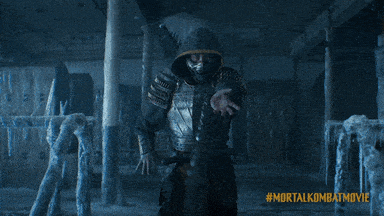
So, Yeah, Scorpion Kills Sub-Zero By Burning The Bastard With Fire Breath Before Returning To Help And Cole Saves His Family....
But As Raiden And His Team Arrive, Shang Tsung Also Arrives Saying That Death Is Just Another Portal And Next Time, He Will Come With Armies Before Leaving
However, Though They Won This Battle, The Fight Is Not Over By Any Means As Raiden Assembles A New List Of Champions For The Team To Recruit...
Packing Up His Locker At The Wrestling Ring, Cole Tells His Agent That He's Going To Hollywood As We Look At A Poster That Tells Us Johnny Cage Will Be In The Sequel...
This Movie Was...Pretty Damn Epic!
How This Isn't One Of The Best Video Game Movie Adaptations Ever I Will Never Know, I Guess It Just Comes Down To People Are Idiots And Don't Know What The Hell They're Talking About...
"The Story Is Confusing" If The Story Is Confusing Then You Don't Belong Reviewing Movies Cause You Have No Idea What A Good Movie Is!, "The Movie Has Horrible Writing" Have You Even Seen The Original Mortal Kombat Movie? That And Annihilation Have Worse Writing Than This Movie! "We Should Have Had Johnny Cage Instead Of Cole" We're Getting Him In The Sequel, Give The Writers A Freaking Break And Stop Being Critical Pricks!
So, Yeah, It's Obvious That This Has Become My Favorite Video Game Movie And I Say Don't Listen To People Like Angry Joe Or Hack The Movies Who Don't Know What They're Talking About And Go See This Movie
Till Next Time, This Is Duke, Signing Off
4 notes
·
View notes
Text
A short history of dueling in France
Dueling is a custom of fighting by arms, according to precise rules, to settle a dispute between two adversaries, one asking the other for compensation for an offense or a wrong. In Europe, it is preceded by a challenge, usually signified by a cartel. The fight takes place in front of arbitrators, now called witnesses, who ensure compliance with the rules and specific conventions fixed in advance (number of hits by bladed weapon or firearm). In a pleasure duel (to show off) the number of hits is fixed. In a duel to the death, we speak of "excessive duel".
The duel was aimed at regulating and limiting the violence caused by a conflict between two individuals. By fixing the terms for the resolution of the conflict, it obliged the opposing parties to agree through dialogue on settled upon conditions and constituted a kind of contractual criminal law, the judicial duel. Integrated in the late Middle Ages into criminal procedure by different customs, the legal duel evolved between the Hundred Years War and the Renaissance in private law contracts as parliaments refined the case law and the monarchy grew stronger. In modern times, the duel is no more than a form of bravado against ordinary law, the duel of the point of honor.
A form of dueling was observed in other societies, in particular in Japan, but it was then a practice reserved for the military. However, by imposing individual weapons of war, that is to say by prohibiting the use of fists, for example, the duel mainly concerned the nobility, trained in fencing and shooting. The gentlemen ended up condescending to indulge themselves only among themselves: "Game of hands, game of villains". The spirit which governed it thus gave more value to dignity than to life, to manner rather than to interest, and claimed the primacy of individual freedom to regulate its affairs over recourse to public justice. Defended in the past by both supporters of an aristocratic regime and by Republicans, dueling is nowadays prohibited in most countries.
The oldest known form of the duel seems to be the judicial duel practiced by the Ancient Germans, already reported by Caesar. This form has slowly evolved over the centuries to lead to the duel of honor. To settle private disputes, you can fight, the gods will decide. In 502 among the Burgundians, the Gombette law codified the custom and introduced the concept of "champion."
The Church disapproved and fought against a custom deeply rooted in European culture.
The rules were the same everywhere: there is a gesture of defiance, it is noted, the meeting takes place in a closed, delimited place, there is a search to ensure that the combatants are on equal terms, and this is done in front of witnesses and after a religious ceremony.
The defeated duelist, found guilty, was hanged.
In 805 Charlemagne introduced the use of the stick in duels. However the stick would quickly become the weapon of the commoners while the nobles fought with the sword.
The Kings of France opposed it, especially during the 13th century. Saint Louis (Louis IX) in his Great Ordinance of 1254, wanted to return in judicial matters to the evidence by witnesses. Little by little, the nobility began to consider the duel as a way to challenge royal authority, and thereby assert their independence.
Philippe le Bel (Philippe IV) officially reintroduced the judicial duel by restricting it to the most serious crimes, by imposing financial formalities, and prohibiting it in time of war. The number of duels drastically decreased.
On July 10, 1547, the famous duel in Saint-Germain-en-Laye between Guy Chabot de Jarnac and François de La Châtaigneraie brought about the end of the legal duels.

Time for the great hours of the duel of point of honor!
The latter developed following the Italian wars. People defied royal power for any reason. For the most futile reasons, they challenge and killed each other and themselves, because they had to "defend their honor." It was part of the everyday landscape.

The King of France no longer giving permission to fight, people did without it, the legal duel then taking on a new form in the 16th century, the duel of the point of honor. In the desire to brave the growing royal power, they fought for any reason, and if necessary they invented a pretext concerning their honor (private or public) when the desire came to want to simply confront another with weapons in hand . The duel became a fashion, and under the influence of the Italian masters, the sword became its almost exclusive weapon with the dagger and, sometimes, the spear. The witnesses, called "seconds", from passive actors they were at the start, took more and more part in the duels they were supposed to arbitrate. In 1652, during the duel of the Dukes of Nemours and Beaufort, there were ten people who fought together in the horse market where the meeting took place. Three people were killed and several injured.
It was a massive phenomenon; people fought in the squares of towns and villages, in the streets, especially in the woods. Some places were very famous with duelists. Where is the current Place des Vosges, a large space near the Porte Saint-Antoine was very popular with duelists.

These duels escaped justice and clerical power. The Council of Trent may excommunicate the duellists, nothing helps. In France, between 1588 and 1608, more than 10,000 gentlemen killed themselves in a duel (and that only counts the nobles!), 4,000 in the year 1607 alone according to contemporaries: it is more than the Wars of Religion.
The Kings opposed it; we can note a large number of prohibition edicts, particularly from 1599 (1599, 1602, 1613, 1617, 1623). But they were themselves part of this combative aristocracy, and showed indulgence towards the duellists (Henri IV signed many graces in such circumstances - 7000 in 19 years).
Many nobles stupidly perished in a duel and the ban became a necessity. The state assumed the " monopoly of violence" and determined to tame the nobility.
But it was with Richelieu, whose brother had been killed in a duel, that the fight against the duel took a sharp turn (for a moment). Now the duel, assimilated to high treason, was to be punished with death.
On February 6, 1626, Richelieu prohibited dueling.
"Sire, it is a matter of strangling duels or strangling Your Majesty's laws."
No mercy for the duellists, it would be exile or beheading.
And on June 22, 1627 was beheaded François de Montmorency-Bouteville for fighting in broad daylight, Place Royale, against François II d'Harcourt, Marquis de Beuvron, who fled to England. The scandal of a youth killing themselves for frivolous reasons was denounced at the very heart of the Court by the great poet Malherbe whose son, himself a duelist who had received a pardon, was assassinated on July 13, 1627 for having prevented a duel.
The very severe sentence raised a wave of protest from the nobles, but the king and the cardinal did not flinch, and the execution for the example took place.
The repression continued under Louis XIV, Louis XVI .. The duels still existed (even ecclesiastics were fond of them,such as the Cardinal de Retz) they were only more discreet. In the woods, for example. There were areas of lawlessness like the Court of Miracles in Paris, where you could fight.
The Revolution abolished the royal edicts, and the duel made a powerful comeback. Except that it was now democratized: now everyone was fighting. At the fall of the Empire, demobilized officers attacked the Prussians or the legitimists. People were fighting for anything. And anywhere. In 1808, two men fought in balloons above Paris - one of the combatants was shot down and died with his witness. In 1843, two others fought with billiard balls.
In 1834 the Count of Chatauvillard published his Essay on the Duel, a true manual for the duelist.
Everyone was fighting. Debates in the Assembly often ended in a closed field with witnesses. This was the time of the cloak and daggers novels, whose authors themselves fought in duels. All the big names of the time duelled at least once.
Between 1826 and 1834 there were in France more than two hundred dead by duel.
Now for some famous duels of the XIXth century:
On May 31, 1832, Evariste Gallois, 20 years old, very brilliant and promising mathematician, just after having published his theory of ambiguity (which is still studied today), died in a duel with a lieutenant of cavalry who was more experienced than him.
On July 24, 1836, Armand Carrel died while fighting against Emile de Girardin.
A famous pistol duel took place in Saint Petersburg on January 27, 1837, and the great Russian writer Alexandre Pushkin was killed by French Lieutenant Georges d'Anthès.

During the Belle Epoque, highly regulated duels were stopped at first blood. It was a great passion.
We can find among the duelists Ledru-Rollin, Proudhon, Alexandre Dumas, Lamartine, Victor Hugo, Adolphe Thiers, Léon Gambetta, Jules Ferry, Aristide Briand, Léon Blum, Georges Clemenceau (12 personal duels plus 5 as a witness for the Tiger!), Marcel Proust (yes, even him!), and the future presidents Raymond Poincaré and Paul Deschanel.
Men, you might think. Well ... not only!
Without counting the famous Julie d'Aubigny (Mademoiselle de Maupin) with her novel-like life, we can mention the famous duel which in September 1718 opposed two lovers of the Duke of Richelieu (not the Cardinal ... but a descendant of his family), the Marquise de Nesle and the Comtesse de Polignac. They fought for his love and got little for their pains, since the Duke left them both for the Regent's daughter.

The Great War will be a game-changer. It is possible that only something that big could durably affect society to the point it would give up such a long held tradition. After such devastation and the priority given to collective defense rather than individual combat, to die "for honor" suddenly seemed very absurd.
Some nostalgics continued, but the duel fell out of favor.
The last duel in France happened in 1967 between two parliamentarians, Gaston Defferre and René Ribière (because one said to the other in the middle of the Assembly: Shut up, you idiot!)

And nowadays... Some lone voices still talk about dueling.
Sources:
Wikipedia, le Duel (Article in French)
www.defense.gouv.fr
Pariszigzag, l'Histoire Insolite des duels et de leur répression
Ouest France, Edition du Soir, Pourquoi les Français ont adoré les duels ? 3 mai 2017
Infos Toulouse, Le duel: un code d'honneur historique, 9 août 2019
#history of dueling#duels in france#from the VIth to the XXth century#if you want to know more about specific duels ask me
77 notes
·
View notes
Text

By: Amy Fredrickson
Artemisia Gentileschi was born on July 8, 1593, in Rome and is one of the most distinguished artists of her generation. She challenged the societal limitations placed on female artists during her time and became a successful history painter in her own right. Her career took her from Rome to Florence, Venice, London, and Naples, where she worked for elite patrons such as the Medici family in Florence and King Philip IV of Spain.
Artemisia was the eldest of Prudenzia Montoni and Orazio Lomi Gentileschi’s (1563–1639) five children as well as their only daughter. She was born into an artistic family. In addition to her father, her grandfather Baccio Lomi (c.1550–1595) and her uncle Aurelio Lomi (1556 – 1622) were well-known Pisan painters.

Originally a mannerist-style painter, Orazio became a follower of Caravaggio’s practice of working from nature, and he trained Artemisia to paint in this manner. As a child, Artemisia worked in his studio, mixing pigments and making varnishes. She learned the techniques of chiaroscuro, which was characteristic of Caravaggist paintings. In turn, Artemisia was a second-generation champion of Caravaggio’s realism; her first recorded paintings are almost indistinguishable from her father’s, such as Susanna and the Elders (1610). Painted a few years later, Judith and Her Maidservant (c.1614-20) in the Palazzo Pitti sets her apart from Orazio for its emotive protagonists and deep tenebrism.
Orazio hired painter Agostino Tassi (1578 – 1644) to tutor Artemisia. In the spring of 1611, Tassi raped her, and he refused to fulfill his promise to marry her. Orazio took him to trial because the crime against his daughter was a crime against his family’s honor. Artemisia’s infamous 1612 trial was well-documented and lasted seven months. She was forced to provide a testimony under torture. Found guilty, Tassi was sentenced to banishment from Rome for five months; however, his punishment was not enforced.
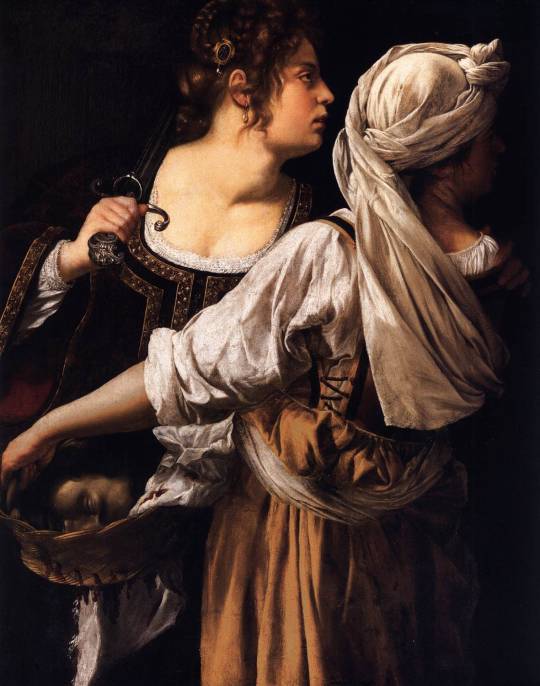
Shortly after, Artemisia married Florentine artist Pietro Antonio di Vincenzo Stiattes (b.1584), and they moved to Florence. Before their arrival, Orazio wrote to the dowager Grand Duchess of Tuscany, Christina of Lorraine, requesting her help in preventing Agostino Tassi's release from the Corte Savella where he was being jailed. In return, Orazio offered to send her one of Artemisia's paintings, Judith and Her Maidservant (c.1614-20).
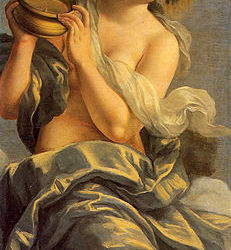
Artemisia established herself as an independent artist in Florence, and she began developing her distinct style. She pushed against the societal norms established for women during her time, such as relegating women painters to the genre of still life or portraiture. Instead, she concentrated on history painting. She established herself within Florentine literary circles, which led to commissions from the Medici family and Michelangelo Buonarotti the Younger. She painted Judith and Holofernes (c. 1612–1621) and the Penitent Mary Magdalene (1620–1625) in the Palazzo Pitti for the Medicis, and for Casa Buonarotti, she painted a ceiling painting called the Allegory of Inclination (1615–1617). Her Florentine paintings illustrate her development beyond her father’s teachings and those of Caravaggio as she introduced a more polished surface, brighter colors, and sophisticated iconography. Perhaps these advances were a product of her association with the poets, painters, and intellectuals she had encountered in Florence. In 1616, Artemisia became the first female member of the Accademia delle Arti del Disegno.

Artemisia was business savvy; she ran her own studio and controlled her finances. The move to Rome may have coincided with Grand Duke Cosimo II de’ Medici’s death in 1621. His successor was Ferdinando, his ten-year-old son, who was governed by his mother and grandmother, and ultimately, their tastes leaned toward penitent biblical figures rather than Artemisia’s bloodletting heroines.
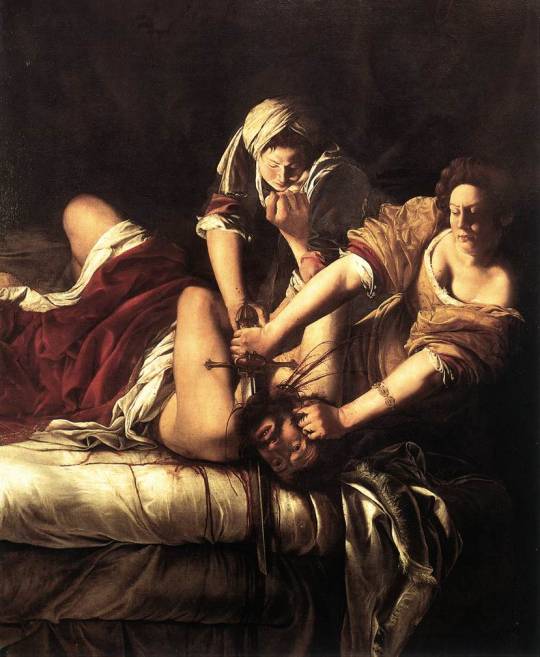
In 1620, Artemisia and her husband returned to Rome for approximately six years. Judith and her Maidservant (c. 1623-25), now in Detroit, dates to this time, although how many paintings Artemisia produced during her second Roman period is unclear. Little is known about her involvement in Roman artistic circles of this period, yet Simon Vouet’s portrait of Artemisia for the papal secretary Cassiano dal Pozzo provides some insight that she was associated with an elite circle of patrons and possibly the Academy of the Desiosi.
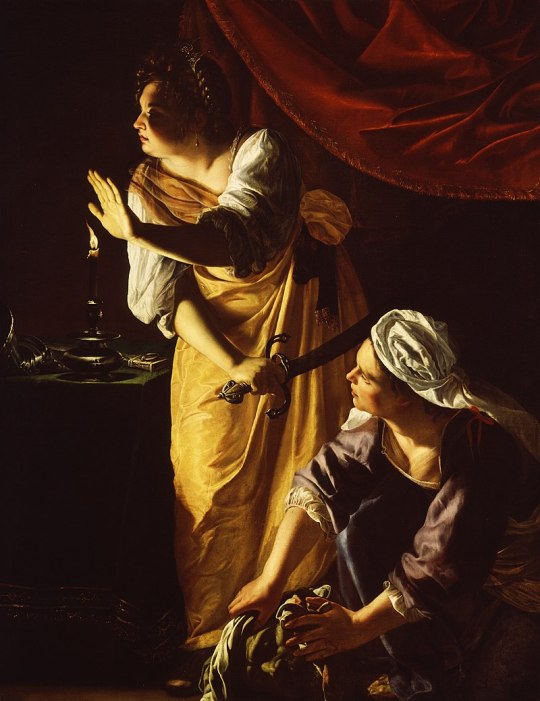
In 1627, Artemisia traveled to Venice for a few years to possibly attain commissions. During her Venetian sojourn, she participated in literary circles such as the Accademia degli Incogniti. Venetian poetry of this time alludes to her status in these circles. While in Venice, Artemisia began to specialize in monumental biblical and historic women; the subject of these paintings featured the triumphs and tragedies of these heroines.

In 1629, the Spanish viceroy, the Duke of Alcalá, invited Artemisia to Naples, and a year later, she resided in Naples and ran a successful studio. A remarkable example of this period is her Esther before Ahasuerus (1627-1630), which hints at her Venetian sojourn. The incorporated grandiose movements and ornamental dress emit an operatic air.

Her recently discovered paintings, such as Corsica and the Satyr (c. 1630-35) and Christ and the Samaritan Women (c. 1637), reveal that the 1630s marked a high point in her career. What sets these works apart from her earlier paintings are her lyrical subjects and the loose Venetian-inspired brushwork of broad white strokes with colors applied on top. During the 1630s, she began incorporating rich colors, such as ochres, blues, and cinnabar red. Artemisia created dimension and drama through her use of such rich hues.

Artemisia left Naples in 1638 to assist her ill father in London. Orazio worked for the English court beginning in 1626 and was working on ceiling paintings for the Great Hall in the Queen’s House in Greenwich. By 1640, she returned to Naples, where she remained until her death. It is unknown when she died, but a recently discovered document shows her living in Naples in August 1654. It is plausible that Artemisia died during the 1656 plague that had ravaged Naples and killed half of its inhabitants.
Images:
Self-Portrait as the Allegory of Painting, c.1630, oil on canvas, 96,5 x 73,7 cm., Royal Collection, Windsor
Susanna and the Elders, 1610, oil on canvas, 170 x 121 cm., Schloss Weissenstein, Pommersfelden
Judith and Her Maidservant, c.1614-20, oil on canvas, 114 x 93.5 cm., Galleria Palatina (Palazzo Pitti), Florence
Allegory of Inclination, c. 1615, oil on canvas (ceiling), 152 cm × 61 cm., Casa Buonarroti, Florence
The Penitent Mary Magdalen, 1620-25, oil on canvas, 146 x 109 cm., Galleria Palatina (Palazzo Pitti), Florence
Judith Beheading Holofernes, 1612-21, oil on canvas, 199 x 162 cm.,
Galleria degli Uffizi, Florence
Judith and her Maidservant, c. 1623–1625, oil on canvas, 184 x 141.6 cm., Detroit Institute of Art.
Esther Before Ahasuerus, c. 1627-1630, oil on canvas, 208.3 cm x 273.7 cm., Metropolitan Museum of Art.
Corsica and the Satyr, c.1630-35, oil on canvas, 155 x 210 cm., Private Collection.
Christ and the Samaritan Women, c. 1637, oil on canvas, 267.5 x 206 cm., Private Collection.
References:
Sheila Barker, 'Artemisia's Money: The Entrepreneurship of a Women Artist in Seventeenth-Century Florence,' Artemisia Gentileschi in a Changing Light, ed. by Sheila Barker (London, 2018), pp 59-88
Breeze Barrington, 25 April 2020, "The Trials And Triumphs Of Artemisia Gentileschi," Apollo Magazine. [online] <https://www.apollo magazine.com/artemisia-gentileschi-london/>
Ward R. Bissell, Artemisia and the Authority of Art: Critical Reading and
Catalogue Raisonné (University Park, 1999)
Ward R. Bissell,‘Artemisia Gentileschi-A New Documented Chronology,’ The
Art Bulletin 50, no. 2, (1968), pp. 153–168.
Patrizia Costa, ‘Artemisia Gentileschi in Venice’, Source: Notes in the History of Art 19, no. 3, (2000), pp. 28-36
Mary D. Garrard, 'Artemisia Gentileschi's 'Corisca and the Satyr,'' The Burlington Magazine 135, no. 1078 (1993), pp. 34-38
Mary D. Garrard, Artemisia Gentileschi: The Image of the Female Hero in Italian Baroque Art (Princeton, 1989)
Jesse Locker, Artemisia Gentileschi: The Language of Painting (New Haven, 2015)
#artemisia#artemisia gentileschi#florence#rome#caravaggisti#Caravaggio#Baroque Art#women artists#female artist#heroines#judith#judith and holofernes#susanna and the elders#self portrait
49 notes
·
View notes
Photo


Levantando la Duodécima | 03.06.2017
441 notes
·
View notes
Photo


WE LOVE YOU CHELSEA, WE DO.
7 notes
·
View notes
Photo

The Four Seasons, Kano Tan’yū, 1668, Cleveland Museum of Art: Japanese Art
Tan'yū's skills were honed early within the regimen of the Kano family's painting studio. His grandfather, Eitoku (1543–1590) was the Momoyama period's most sought-after painter, a champion of colorful, large-scale painting compositions who worked for several of the country's most powerful leaders. When the young Tan'yū was summoned to Edo in 1617 by the shogun to become a member of the new capital's official painting studio, few opportunities to work on similarly ambitious projects existed. Yet by the end of his career, Tan'yū had supervised the execution and installation of linked mural painting compositions in several of Japan's most prestigious residences and castles. As an official court painter to the first shogun, Tokugawa Ieyasu (reigned 1603–5), and then his successors, Tan'yū appears to have successfully juggled his official duties with private activities as a teacher, as the era's leading connoisseur of classic Chinese and Japanese painting, and as a practicing artist. His surviving compositions as well as thousands of sketches far surpass the oeuvre of any of his contemporaries. While studio assistants surely contributed to his oeuvre, just as later imitators consciously confused his accomplishments, a clearer image of the painter has emerged in recent years that better conforms with his contemporary acclaim as recorded in seventeenth- and eighteenth-century documents.
Tan'yū can now be seen as an artist adept in virtually all traditional ink painting subject matter, which he often presented in novel interpretations. Equally important are his rare screen (byōbu) compositions executed in a pure yamato-e manner with vivid mineral pigments on a gold-foil background. This pair of byōbu presents Tan'yū's more orthodox approach to academic ink painting methods embracing Chinese themes that had been interpreted by numerous Japanese ink painters over the centuries. Thus a typical view of residences and human activities set along the shores of an impressive river (or lake) is enlivened by the Japanese proclivity for including seasonal references. Proceeding from right to left, the viewer passes sequentially from spring to the snow-laden branches of winter.
Tan'yū lends considerable atmospherics to the panorama in his use of misty cloud banks, frequently set off by sharp, darkened ink lines or whole areas of ink washes of variegated tonalities. The spring and summer views are particularly notable in this regard, as is the presence of the artist's signature on both byōbu, attesting to their completion in Tan'yū's sixty-seventh year (1668)—50 years after he left Kyoto for the capital, and 30 years following his adoption of the artist name "Tan'yū" (in 1635). From 1622, when he began work on the mural paintings for Edo castle (the shogun's formal residence), through the completion of the painting cycle in 1636 for the Tokugawa family mausoleum in Nikkō to the north of Edo, Tan'yū's skills as head of an accomplished painting studio as well as a master painter found their most impressive expression in large-scale compositions. In 1638 he received the honorary Buddhist title Hōgen (Eye of the Law). It is intriguing therefore that relatively few independent byōbu paintings from the master's hand survive, particularly documented early works.
Size: Image: 174 x 381 cm (68 1/2 x 150 in.)
Medium: Six-panel folding screen, ink and slight color on paper
https://clevelandart.org/art/1992.394.1
22 notes
·
View notes
